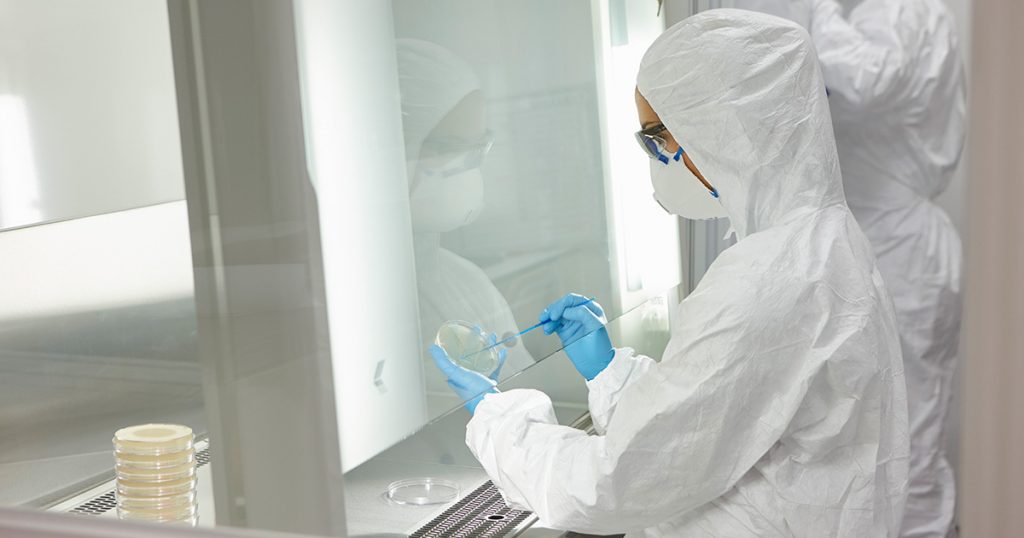Company News
ALLpaQ Achieves EcoVadis Gold: A Milestone in Our Ongoing Sustainability Journey
We’re thrilled to announce that ALLpaQ has been awarded EcoVadis Gold – a globally recognised benchmark that places us among […]
Jun 12th, 2025

ALLpaQ Achieves EcoVadis Gold: A Milestone in Our Ongoing Sustainability Journey
Jun 12th, 2025
We all understand the value of a cleanroom to the successful development and production of bioprocess and pharmaceutical products. But what is their history?
Cleanrooms are used in a variety of industries including life sciences and pharmaceuticals as well as by the military and aerospace.
A cleanroom is completely blocked off from the outside world and access is strictly controlled. As well as human factors and airborne contaminants, other elements which are controlled and measured include the pressure, temperature and humidity.
But where and when did the brilliant idea of creating cleanrooms come from?
When dealing with biochemical materials, isolation from the outside environment is crucial as any potential contaminants could disrupt production.
The importance of hygiene in laboratories and hospitals has, of course, been long understood thanks to the work of Pasteur, Lister, etc. It became obvious, early on, that good ventilation was a crucial way of reducing the transmission of pathogens in hospitals. But, the first time this was applied to manufacturing was during WW2.
As William Whyte says in his introduction to his 1991 book Cleanroom Design: “It was realised that the cleanliness of the production environment had to be improved or such items as bomb sights and precision bearings would malfunction”.
Not inappropriately, then, entering a bioprocessing cleanroom is akin to a military operation, with access restricted to authorised personnel only and strict gowning protocols. We discuss a range of cleanroom best practices in this article.
Any contamination from the outside world could disrupt the delicate processes taking place inside the cleanroom. This is in addition to the risk of infection or chemical injuries from the substances themselves. Therefore, it’s important both human and cleanroom contents are protected from each other.
The strict hygiene and PPE policies, the use of airlocks and the mandatory wearing of face masks is all designed to protect the entire body from contaminating the clean room area and, also, to protect against being contaminated.

The control of ventilation and the filtration of incoming air was the key development in the introduction of cleanrooms.
Air filters began to be used in British gas masks in WW2, then the technology took a quantum leap when HEPA (High-Efficiency Particulate Air) filters were developed to keep workers safe when handling radioactive materials for The Manhattan Project.
This technology became available for industrial use in the early 1950s. Additional developments in Laminar Flow technology were developed in the early 1960s.
A laminar flow controls the direction and velocity of air movement in the cleanroom, ensuring that it flows smoothly and without turbulence. The air typically passes through HEPA filters, to remove any particles and contaminants, and is then released into the cleanroom in a uniform and controlled manner.
Such laminar flow is often directed downward from the ceiling and passes-out through floor-level vents or grilles. This downward flow helps ensure that any contaminants that are released in the cleanroom are quickly transported away from the cleanroom workers and are removed from the space.
What we recognise as a modern cleanroom has been used in various capacities both in manufacturing as well as in military and aerospace applications since the 1960s.
1960s:
Industry began to recognize the importance of maintaining sterile environments for the production of, particularly, pharmaceutical products both in terms of the medicines which are administered as well as the medical equipment that is used in patient care.
1970s:
Countries such as the US and the UK began publishing guidelines for the production of sterile products, which included recommendations for cleanroom design and operation.
1980s:
The concept of “aseptic processing” became widely adopted in the pharmaceutical industry, combining cleanroom technology and sterile processing techniques to prevent contamination during the production of sterile products.
1990s:
A new regulatory framework was developed, including ISO standards, US Federal standards, EU GMP classifications and British BS standards. This led to even greater production quality.
2000s:
Advances in cleanroom technology, such as the use of airlocks, isolators and barrier systems, allowed for even greater levels of control over the production environment.
| Cleanroom applications in modern manufacturing | |
| Life Sciences | Antibiotic production, vaccine production, genetic engineering |
| Pharmaceuticals | Sterile pharmaceuticals and tools |
| Nanotechnology | Fuel cells, solar cells, agricultural research, medical devices |
| Electronics | Computers, TVs, Mobile phones |
| Computing | Semiconductors, integrated circuits |
| Optics | Lenses, laser equipment |
| Cosmetics | Allergen control for any products that contact the skin |
| Food & Drink | Control of allergen contamination throughout the supply chain |
| Hospitals | Immunodeficiency therapy, Isolating contagious patients, ORs |
ALLpaQ Cleanroom Bioprocess Containers are competitively-priced, space-efficient and user-friendly. The containers open on all four sides to ensure flexibility of tube routing and ease of cleaning, and can also be stacked and moved when full, and collapsed when empty to minimise wasted space.
Check out our full range of Cleanroom Containers here, and learn more about the revolutionary features we have built into them.
We’re always consulting with our clients and always striving to improve the efficiency, usability and hygienic qualities of our products. That’s why ALLpaQ Cleanroom Bioprocess Containers can be customised to fit any single-use bag configuration and assembly, regardless of the manufacturer.
For all your cleanroom needs, get in touch today. Give us a ring on +44 (0) 1472 800 373, or fill in the form below.